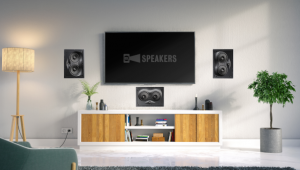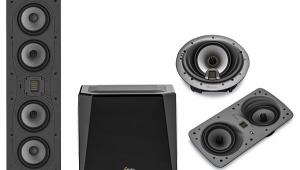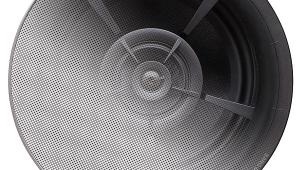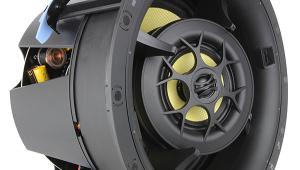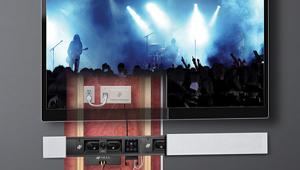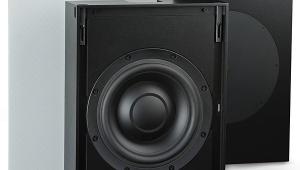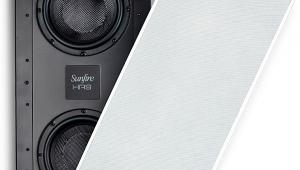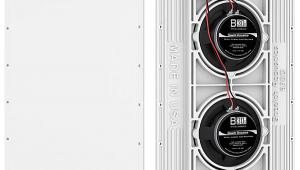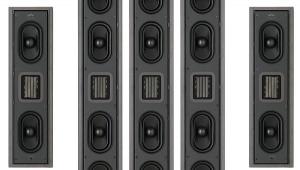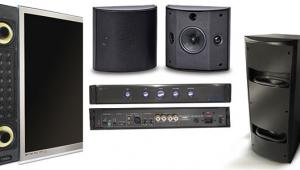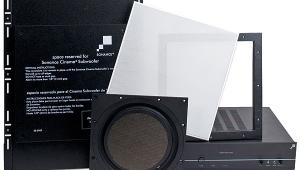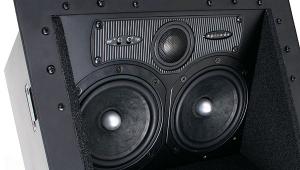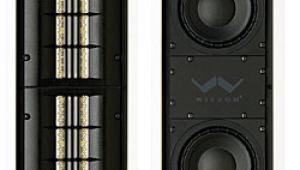Wisdom Audio Insight P4i In-Wall Speaker System Page 2
PMD (Pretty Much Delightful)
With all this high-tech wizardry it’s easy to talk the audiophile talk, but do these new Wisdom Audio in-wall speakers walk the audiophile walk?
As it happens, Wisdom Audio’s Insight P4i in-walls don’t walk the audiophile walk—they run. It always amazes me how good an architectural speaker can sound when a company throws away preconceptions and puts its collective mind to the task of designing a high-performance in-wall. The PMDs in the P4is have a very open, airy sound that’s reminiscent of what you’ll hear with a good electrostatic speaker or a folded-planar magnetic tweeter. Although they come just short of having what could be called the dynamic ultra-realism that comes with the best electrostatic designs, in many ways the PMD’s laid-back nature is just as appealing. To say the PMDs are more neutral is not correct. Perhaps it’s better to say that they’re reluctant to attract as much attention to themselves.
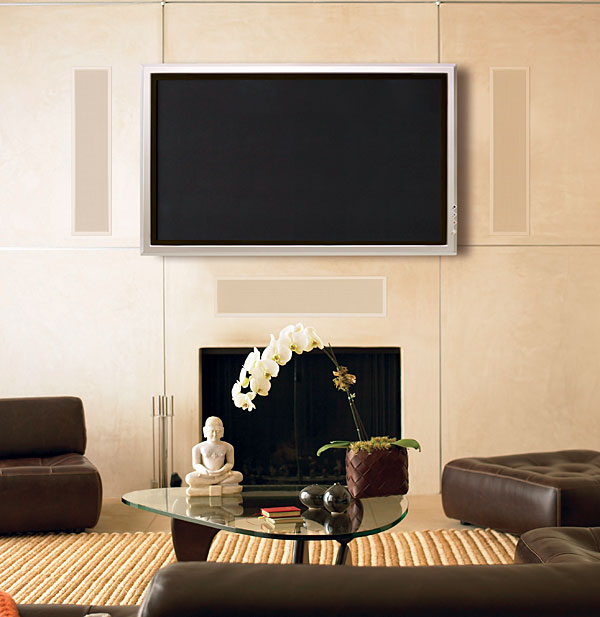
It’s just a smooth ride all the way from bottom to top. With the sorrowful “When Kafka Was the Rage” from Dave’s True Story’s Unauthorized (Chesky Records calls it a “paeon to love lost”), Kelly Flint’s voice was gracefully layered in front of the drums, violin, and Dave Cantor’s guitar. Throughout, the P4i was as seductive as Flint’s voice. The PMDs maintained their tranquil, silky nature while playing the more edgy (but still woeful) “Elegy for Dunkirk” (Jeff Beck, Emotion and Commotion) featuring intense electric guitar playing by Beck that’s countered by the soaring “wordless vocals” of opera singer Olivia Safe. Here, again, the P4i was a joy to listen to; and, with the exception of a bit of compression in the depth of the soundstage (something virtually all in-wall speakers suffer from), it’s every bit as impressive for music as nearly any equally priced in-room speaker.
Because in-walls and on-walls are not always able to be placed in the ideal locations in a home theater room (not everyone wants to go around sawing the studs in their walls in half), it’s not always easy to get one of these systems to create a soundfield that’s as coherent and enveloping as a system comprised of out-of-the-wall speakers. The PMDs in the P2i speakers I was using for the surround channels (as well as those in the P4i) have a very wide dispersion pattern, and this—along with well-matched timbre between the front and surround channels, helped generate an extremely unified and believable surrounding soundfield. The movie Dark Skies relies heavily on its soundtrack and special effects to continually build a frighteningly eerie state of mind. Even in simple scenes, such as when Sam’s father, Daniel, frantically searches his son’s room for some mysteriously missing family photos, the surround channels are vitally important to create foreboding suspense. There’s a strange wobbling of the entire space that happens during the search as well as during the separate conversation between Sam and Jesse that’s taking place simultaneously in Jesse’s room. The surround P2i speakers blend spectacularly well with the P4is in the front, especially when the warbling gradually morphs into a high-pitched whine. At one point, what are (I think) the muffled sounds of the parents arguing in Sam’s room—but what could just as easily be the scratchy voice of a lurking demon—are placed well off to the left side of the room halfway between the front and back. Although the noise is purposely unintelligible, it’s totally distinct and locked in its place as an element of the soundtrack. And, of course, that’s just the beginning.
As Wisdom Audio promised, the P4i I mounted horizontally for the center channel performed just as engagingly as did the vertical P4is. It works spectacularly well, as a matter of fact. The dialogue is crisp and clear, whether it’s in the middle of the fear-fueling mystical mayhem of Dark Skies or highlighting the multiple soon-to-be-classic Schwarzenegger one-liners in The Last Stand. Thanks to its point-source design, the timbre stayed consistent even at off-center listing positions.
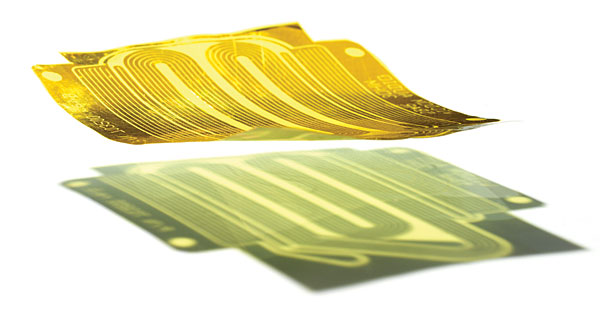
By this point, I shouldn’t be surprised—although I continually am—at how often subtle acoustic elements in soundtracks, which, on the surface, seem so relatively innocuous, can have such a powerful emotional impact. It’s at moments such as these when the audiophile pedigree of the Insight P4i/P2i combination proves its cinematic worth. For example, interspersed amongst the rapidly mounting body count in The Last Stand are moments of extreme angst, such as when the sheriff, Ray (Arnold Schwarzenegger), is rushing his mortally wounded subordinate, Jerry (Zach Gilford), to the hospital after a desert shootout with drug cartel members. As Jerry is dying in the arms of his partner, Sarah (Jamie Alexander), the sound of the police siren from the cruiser following behind gradually fills the room in an echoey, hauntingly dreamlike way. Not only is it impossible to tell where the P4is end and the P2is begin, but the arc of the siren from low to high is smooth and sharp without being shrill.
The bass output of the Insight P4is drops off significantly below around 50 Hz, which is not surprising considering all we’re dealing with is two pair of 3 x 5-inch bass drivers in each P4i in an infinite baffle design. I didn’t have the chance to audition Wisdom Audio’s narrow SCS Suitcase Subwoofer, but the Sunfire HRS-IW8 in-wall subwoofer turned out to be an excellent match for the obround drivers in the P4i and P2i. While the HRS-IW8’s anti-resonant cabinet design is a different way of countering wallboard vibrations than Wisdom Audio’s Uni-grip mounting system, both techniques worked splendidly at eliminating the suspension of disbelief that you get from a bad wall buzz during a movie.
Insights Are Out of Sight
I’m totally smitten with Wisdom Audio’s Insight P4i and P2i in-wall—I mean, architectural—speakers. They are an absolute delight to listen to. Regardless of the source material, be it musical or cinematic in nature, the P4i speakers never caused me a moment of disappointment. Yes, planar magnetic drivers are uncommon, but they proved themselves here to be uncommonly good. Even if you think you can’t afford to part with this much coin, it’s absolutely worth busting your budget if you’re looking for an in-wall system you won’t have to apologize to your audiophile friends for owning. If you’ll pardon the pun, without a doubt, these Insights are out of sight.
